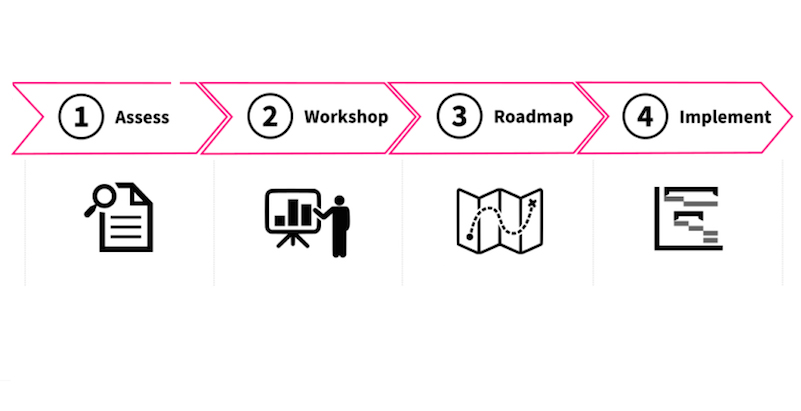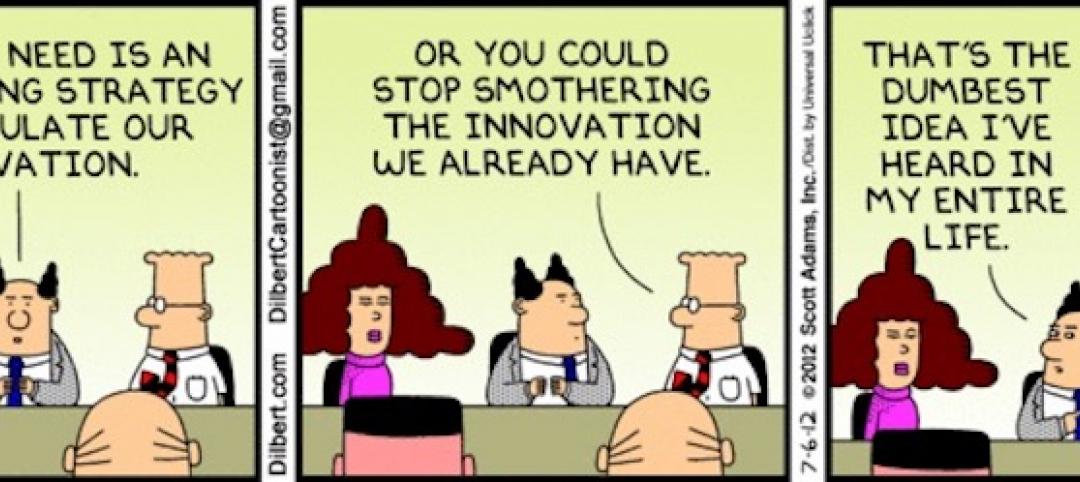It is ten minutes before 9:00 AM and I am about to begin a day of strategic technology discussions with a new client. A whiteboard with markers sits at the ready as I anxiously await the arrival of the first stakeholder group: the executives.
While I will be spending nearly the entire day with managers and project teams, the executive group will tell me much about the company’s current capacity to deliver change and implement new processes within the organization. However, what I will be looking for is not a sense of technological know-how, marketing savviness, or even strategic smarts. I am interested in discovering something far more nebulous and not easily quantified: Is this a healthy company?
Will the company executives demonstrate trust in their ranks? Do they communicate their vision with clarity to their staff and clients? If there are conflicting opinions, will the debate be productive or rife with cynical disagreement? And perhaps most importantly: are the leaders aligned in their ideas about what is important for the greater good of their company’s future?
'Rarely do I hear that the executives are actively evaluating the status of their technology initiatives in the same way they might review a quarterly financial report or marketing update.'
Though these questions may seem obvious or even subjective, their answers are often much better predictors of successful organizational transformation than current levels of technology adoption or skillsets. And in today’s conversations about transforming businesses with data, the focus is often on new tools, capabilities, and processes. Less often do I see leaders engage in a discussion about their organizational politics that can either serve to accelerate the growth of a smart business or shut down innovation before it starts.
The following examples are two hypothetical companies derived from my own experience. In both examples, each company has made a strategic decision to invest time and money into implementing data-driven tools and hiring young architects with advanced digital design skills.
Company A invested in a new data-driven workflow and has a leadership team that is aligned on the importance of their investment for achieving the company’s larger mission and values. The leaders frequently and clearly communicate the value of these concepts and their expectations to their departments and managers. The managers actively work to reinforce these concepts in their projects and with the larger staff so they can realize the benefits of a new way of working.
Company B made the same investments as Company A, and although the leaders involved may very much like to see them succeed, the misalignment between different internal stakeholders undermines their priority relative to the overall company mission and values. Leaders infrequently reinforce the importance of their investment to their departments and they do not—or cannot—hold their managers accountable. The managers become hostile to change as they perceive that the new process adds complexity and so they instead fall back to older ways of working under the banner of “getting the project done.”
I have worked with both types of companies and it is no surprise that Company A will often be more successful in ultimately realizing their ambitions. Indeed we can even speculate that if Company B’s resources are far greater, they will only ever realize a fraction of the benefits that their strategic investment could potentially bring to them. The differentiator between the two companies is not in capability, but the relative fitness of their organizational culture.
I believe that the ideas we explore at Proving Ground thrive in healthy organizations. Here are some concepts I often reinforce with company leaders and executives:
Align With Your Company Values
Data and digital tools are an absolute given to today’s building design and construction process. How the technologies are positioned relative to your company’s belief system will ultimately determine how they deliver value to your projects and teams.
I was once a approached by a client to help craft a strategy for their newly formed “building performance team.” One of their goals was to have all of their architectural staff equipped to run basic solar and daylight analysis on their designs over the course of a year. It was a noble ambition. However, there was something critical missing: project teams were measured by productivity, not performance-driven innovation. As a result, project managers tended to be unsupportive and even actively work against activities that were not in support of their primary production goals.
In the near-term, I suggested that they prioritize ways to implement the workflows as a means to satisfy performance-related project requirements in support of production value. In the long-term, the building performance team would have a much greater challenge to work with leaders and managers to position building performance as a core value in the design studio if they wanted to achieve their broader goals.
Establish Accountability
With technology and data situated at the center of our business activities, I am always interested to know how accountability for implementation is established throughout a company. That includes the organization’s leadership all the way down to the project team member. Rarely do I hear that the executives are actively evaluating the status of their technology initiatives in the same way they might review a quarterly financial report or marketing update. More often than not, I hear some version of “That’s an IT thing.” or “That’s what our technology managers are supposed to be doing.”
Recently, one executive expressed his concerns: “We are spending a lot of money on design technology each year,” he said, “However, I keep hearing from our staff that the tools are making the process more complex. Some managers think it is slowing them down.”
“Were managers brought on board with the new investment and how the project process would be affected?” I asked. “How have you been tracking their progress with the new approach?” As it turns out, the company leaders had been hands off with tracking the progress of their very sizeable annual investment. As a result, many of their direct reports (project managers) were not prioritizing the new capabilities and instead viewed them as ‘additional’ to business as usual.
Firstly, I suggested that accountability for a return on their technology investment needed to start with them. They may not be experts or even users of their new technology, but they needed to be proactive in creating clarity around their aspirations and communicate what they expected to see in terms of results. Secondly, I recommended that they ask their managers and leaders to reciprocate and provide regular updates on where they are seeing success (or failure) in the approach. This would reinforce the idea they they are also accountable for the company’s success with the investment.
Over Communicate the Approach
When you introduce a new idea into a company, you are inevitably going to confront processes that have been in place for years and expect people to change their habits. Simply purchasing new software or making new data available is not enough. The act of communicating – and over communicating – the goals and expectations of the new processes can not be understated.
An operations director for a large architecture company reached out about defining tactics to improve their BIM implementation. They were growing concerned that teams were struggling to adopt and implement the firm’s BIM standards and best practices and deliverable quality was suffering as a result. After several discussions with staff members and review of their standards, the issue turn out not to be the lack of quality content, but a lack of awareness that the content existed!
I suggested that the BIM team begin working with the director to craft regular newsletters and internal blog entries. These communications highlighted specific BIM resources and continually reinforced the expectation that these assets were essential resources for project use. Importantly, project success stories were highlighted to demonstrate real-world outcomes. Moreover, in many instances the communications came from the director as a means to demonstrate commitment from company leadership.
Sure enough, not only did the basic communication approach grow the adoption of internal standards over time, others in the company began offering valuable feedback and support for improving upon the content.
The Differentiator
New technology and access to data are often spoke of as a business differentiators for competitive advantage within the AEC industry. However, being an early adopter is a short-lived luxury. All too quickly businesses find that their direct competitors have purchased and are using the exact same tools and have access to the same data.
In my experience, technology-based ‘differentiators’ have less to do with the tools and data alone than the ability to position the capabilities on a bedrock of clear organizational value systems and accountability. These attributes of a healthy business are the engine that will ultimately determine the success of a data strategy. They are also the most enduring characteristics of an organization that will continue to guide it into the future.
Let’s make a roadmap together! Contact me to help define a data innovation strategy for your business.
About the Author: Nathan Miller is the Founder and Managing Director of Proving Ground, a consulting firm focused on helping AEC businesses leverage their data to gain new insights into team productivity, building performance, and user experience. Miller can be reached at: nate@provingground.io.
More from Author
Nathan Miller | Apr 27, 2020
Computers are hard
Sure – computers today look nicer, the experience using them has improved, and we can do exponentially more with them following Moore’s law. But my central observation remains: computers are still hard to use.
Nathan Miller | Nov 26, 2019
Free Generative Design – A brief overview of tools created by the Grasshopper community
For over 12 years, a digital design community made up of professionals, researchers, and academics sprung up around Grasshopper.
Nathan Miller | Nov 11, 2019
Are you creating a culture that is toxic to innovation?
Why are good designers, talented technology experts, and architects leaving practice? Why won’t they stay?
Nathan Miller | May 14, 2018
4 tactics for our digital transformation
While our technology is becoming more advanced, the fundamental processes at the core of design and construction businesses have largely remained unchanged for decades.
Nathan Miller | Mar 7, 2018
Interoperability for the building industry – More wicked problems
This article is a follow up to Nathan Miller's 2016 article “The Wicked Problem of Interoperability”.
Nathan Miller | Aug 22, 2016
The wicked problem of interoperability
Building professionals are often put in a situation where solving problems with the ‘best tool for the job’ comes at the cost of not being able to fully leverage data downstream without limitation, writes Proving Ground's Nathan Miller.












